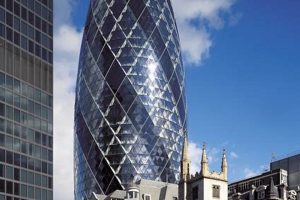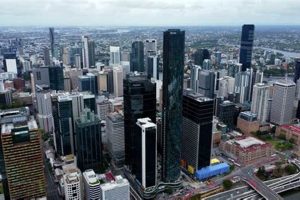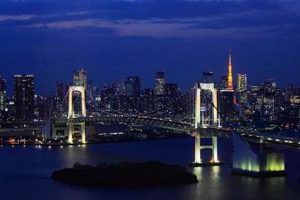Floating skyscrapers are futuristic buildings, conceptualized as skyscrapers not bound to the ground, instead designed to float in the sky. These colossal structures envision a new era of architecture.
The concept of floating skyscrapers offers numerous benefits. They can alleviate the strain on land resources, especially in densely populated urban areas. Additionally, these structures can be strategically positioned to optimize natural resources like sunlight and wind energy.
While the idea of floating skyscrapers is still in its conceptual stages, it has the potential to revolutionize the construction industry. Engineers and architects are continually exploring innovative designs and materials to bring this vision to life.
1. Mobility
The mobility of floating skyscrapers is a game-changing aspect that sets them apart from conventional architecture. Unlike traditional skyscrapers rooted in the ground, floating skyscrapers can be relocated as needed, offering unparalleled flexibility and adaptability.
- Strategic Repositioning: Floating skyscrapers can be strategically repositioned to optimize their use of natural resources, such as sunlight and wind energy, depending on the time of day or year.
- Disaster Avoidance: In the event of natural disasters or emergencies, floating skyscrapers can be moved to safer locations, ensuring the safety of occupants and minimizing damage.
- Urban Redevelopment: Floating skyscrapers can be relocated to accommodate urban redevelopment projects or changing infrastructure needs, providing a flexible solution to evolving urban landscapes.
- Temporary Structures: Floating skyscrapers can serve as temporary structures for events or exhibitions, offering a unique and adaptable solution for short-term space requirements.
The mobility of floating skyscrapers opens up a world of possibilities for urban planning, disaster management, and architectural innovation. Their ability to be relocated as needed makes them a versatile and sustainable solution for the future of architecture.
2. Sustainability
The strategic positioning of floating skyscrapers is a key factor in their sustainability. Unlike traditional skyscrapers that are fixed in one location, floating skyscrapers can be moved to optimize their use of natural resources like sunlight and wind energy. This mobility allows them to take advantage of the most favorable conditions for energy generation, reducing their reliance on fossil fuels.
For example, a floating skyscraper could be positioned to maximize its exposure to sunlight, which can be used to generate solar power. The building could also be equipped with wind turbines to harness the power of the wind. By strategically positioning the building and incorporating renewable energy sources, it is possible to significantly reduce its environmental impact and promote sustainability.
The integration of sustainability into the design of floating skyscrapers is not only important for environmental reasons but also for economic reasons. Buildings that are energy-efficient and environmentally friendly are more attractive to tenants and investors, and they can command higher rents and property values. In addition, the use of renewable energy sources can help to reduce operating costs for the building owners.
Overall, the strategic positioning of floating skyscrapers for optimal utilization of natural resources is a key aspect of their sustainability. By embracing sustainable design principles, floating skyscrapers can help to reduce their environmental impact, promote energy efficiency, and create a more sustainable future.
3. Space Optimization
The burgeoning population in urban centers has resulted in a pressing need for space optimization. Floating skyscrapers emerge as a promising solution, alleviating the strain on land resources and offering innovative approaches to urban planning.
- Vertical Expansion:
Floating skyscrapers maximize vertical space utilization, allowing for the construction of more residential, commercial, and public spaces without encroaching on limited land resources. This strategy is particularly valuable in densely populated cities where land is scarce and expensive.
- Compact Urban Design:
The mobility of floating skyscrapers enables the creation of compact urban designs. Unlike traditional skyscrapers that require large footprints, floating skyscrapers can be positioned closer together, maximizing space utilization while maintaining desirable urban amenities and infrastructure.
- Mixed-Use Developments:
Floating skyscrapers can serve as mixed-use developments, integrating residential, commercial, and recreational spaces within a single structure. This approach optimizes land use by combining multiple functions in one vertical space, reducing urban sprawl and promoting walkability.
- Public Space Creation:
The spaces beneath and around floating skyscrapers can be transformed into public parks, plazas, and promenades. This creates valuable green and recreational areas for urban residents, enhancing the quality of life and promoting a sense of community.
In conclusion, the space optimization capabilities of floating skyscrapers offer a sustainable and innovative solution to the challenges of urban land scarcity. By maximizing vertical space, enabling compact urban design, and integrating mixed-use developments, floating skyscrapers alleviate the strain on land resources and contribute to the creation of vibrant and livable urban environments.
4. Innovative Design
The pursuit of innovative design is the driving force behind the development of floating skyscrapers, as engineers and architects strive to overcome the unique challenges posed by these visionary structures.
- Advanced Materials: The construction of floating skyscrapers requires the use of lightweight and durable materials, such as carbon fiber and graphene, which can withstand the forces of buoyancy and wind. These materials enable the creation of structures that are both strong and buoyant.
- Modular Construction: Floating skyscrapers are often constructed using modular components, which are prefabricated in factories and then assembled on-site. This approach reduces construction time and co
sts, while also ensuring precision and quality control. - Biomimicry: Engineers and architects are drawing inspiration from nature to design floating skyscrapers that are both visually appealing and aerodynamically efficient. For example, some designs incorporate features inspired by fish scales or bird wings to enhance stability and reduce wind resistance.
- Sustainability: The design of floating skyscrapers places a strong emphasis on sustainability. These structures often incorporate renewable energy sources, such as solar panels and wind turbines, to reduce their environmental impact. Additionally, they can be designed to collect and reuse rainwater, and to minimize waste.
These innovative design approaches are essential for bringing the vision of floating skyscrapers to life. They enable engineers and architects to create structures that are not only visually stunning, but also safe, sustainable, and capable of withstanding the rigors of their unique environment.
5. Technological Advancements
The realization of floating skyscrapers hinges upon the integration of cutting-edge technologies in construction, engineering, and sustainable energy. These advancements are not merely components of floating skyscrapers but rather the driving force behind their very existence.
In construction, the use of lightweight and durable materials, such as carbon fiber and graphene, enables the creation of structures that can withstand the unique forces acting upon floating skyscrapers. Advanced engineering techniques, including modular construction and biomimicry, optimize structural stability and efficiency.
Sustainable energy technologies are paramount to the environmental viability of floating skyscrapers. The incorporation of solar panels, wind turbines, and rainwater collection systems reduces reliance on traditional energy sources and minimizes the ecological footprint of these structures.
The practical significance of this understanding lies in the transformative potential of floating skyscrapers. By embracing technological advancements, we can unlock the full capabilities of these visionary structures, creating sustainable and resilient urban environments for the future.
6. Economic Benefits
The economic benefits of floating skyscrapers are multifaceted, promising to transform urban landscapes and stimulate economic growth. These visionary structures can serve as catalysts for tourism, foster the creation of new industries, and revitalize urban areas, creating a ripple effect that benefits entire cities.
- Tourism: Floating skyscrapers, with their architectural marvels and unique experiences, can become major tourist destinations. Visitors from around the world will flock to see these engineering wonders, boosting local economies and creating jobs in the hospitality and tourism sectors.
- New Industries: The construction and maintenance of floating skyscrapers will give rise to new industries and specialized job opportunities. From specialized engineers and architects to skilled construction workers and maintenance personnel, a range of new professions will emerge to support this innovative building typology.
- Urban Revitalization: Floating skyscrapers have the potential to revitalize declining urban areas. By creating new landmarks and attractions, these structures can attract businesses, residents, and visitors, transforming neglected neighborhoods into vibrant and desirable destinations.
- Economic Multiplier Effect: The economic benefits of floating skyscrapers extend beyond the immediate tourism and construction sectors. The presence of these iconic structures can stimulate investment in infrastructure, transportation, and other supporting services, creating a positive multiplier effect that benefits the entire urban economy.
In conclusion, the economic benefits of floating skyscrapers are significant and far-reaching. These structures have the potential to boost tourism, create new industries, revitalize urban areas, and generate a positive economic multiplier effect. As floating skyscrapers continue to evolve from concept to reality, their economic impact is poised to transform cities and economies around the world.
7. Environmental Impact
The environmental impact of floating skyscrapers is a critical consideration that requires careful planning and innovative design strategies. As with any large-scale construction project, floating skyscrapers have the potential to affect the surrounding environment. Therefore, it is essential to conduct thorough environmental impact assessments and implement measures to minimize the ecological footprint of these structures.
One significant environmental concern associated with floating skyscrapers is the potential disturbance to marine ecosystems. The presence of these structures in bodies of water can affect water currents, sediment transport, and marine life. Careful planning and design can mitigate these impacts, such as selecting appropriate locations, using eco-friendly materials, and implementing measures to minimize noise and light pollution.
Another important aspect of environmental sustainability is energy consumption. Floating skyscrapers can be designed to incorporate renewable energy sources, such as solar panels and wind turbines, to reduce their reliance on fossil fuels. Additionally, energy-efficient building systems and appliances can help minimize the overall environmental impact.
Understanding the environmental impact of floating skyscrapers is crucial for responsible development and long-term sustainability. By carefully considering the ecological implications and implementing appropriate mitigation measures, we can ensure that these visionary structures coexist harmoniously with the environment.
8. Future of Architecture
Floating skyscrapers embody a revolutionary approach to architecture, challenging conventional design principles and opening up new possibilities for urban development. This paradigm shift is driven by several interconnected facets that redefine the very nature of buildings:
- Design Flexibility and Adaptation: Unlike traditional skyscrapers rooted in the ground, floating skyscrapers offer unprecedented flexibility in design and adaptation. Their mobility allows for reconfiguration and relocation based on changing needs, promoting sustainable urban planning and resilience.
- Sustainable Urbanization: Floating skyscrapers contribute to sustainable urbanization by optimizing space utilization in densely populated cities. They minimize land use and environmental impact while providing innovative solutions for housing, commercial, and public spaces.
- Integration with Natural Environment: Floating skyscrapers foster a closer relationship between arc
hitecture and the natural environment. Their strategic positioning can harness renewable energy sources and create waterfront promenades, enhancing the quality of urban life and promoting a sense of connection with nature. - Technological Advancements: The design and construction of floating skyscrapers necessitate cutting-edge technological advancements in materials, engineering, and energy efficiency. These innovations drive progress in architecture and engineering, pushing the boundaries of what is possible.
In conclusion, floating skyscrapers represent a paradigm shift in architecture, driven by design flexibility, sustainable urbanization, integration with the natural environment, and technological advancements. They challenge traditional building concepts and open up exciting possibilities for the future of urban design and sustainable living.
FAQs on Floating Skyscrapers
This section addresses frequently asked questions and misconceptions surrounding the concept of floating skyscrapers.
Question 1:Are floating skyscrapers safe and stable?
Answer: Yes, floating skyscrapers are designed to be safe and stable. They utilize advanced engineering techniques, lightweight materials, and sophisticated stabilization systems to withstand environmental forces, ensuring the well-being of occupants.
Question 2:How do floating skyscrapers impact the environment?
Answer: Floating skyscrapers can be designed with sustainability in mind. Incorporating renewable energy sources, eco-friendly materials, and energy-efficient systems helps minimize their environmental footprint. They can also provide opportunities for green spaces and waterfront revitalization.
Question 3:Are floating skyscrapers affordable and accessible?
Answer: While the construction and maintenance costs of floating skyscrapers can be significant, innovative design approaches and technological advancements are continuously being explored to make them more affordable and accessible in the future.
Question 4:How do floating skyscrapers contribute to urban planning?
Answer: Floating skyscrapers offer flexibility in urban planning. They can be relocated or reconfigured to meet changing needs, providing adaptable solutions for population growth, land scarcity, and disaster resilience.
Question 5:What are the technological challenges in constructing floating skyscrapers?
Answer: Floating skyscrapers require innovative materials, advanced engineering techniques, and efficient energy systems. Engineers and architects are continually pushing the boundaries of technology to overcome these challenges and bring these visionary structures to life.
Question 6:How do floating skyscrapers compare to traditional skyscrapers?
Answer: Floating skyscrapers differ from traditional skyscrapers in their mobility, adaptability, and relationship with the surrounding environment. They offer unique opportunities for sustainable urban development and contribute to the evolution of architecture and engineering.
Understanding these FAQs provides a deeper insight into the concept of floating skyscrapers and their potential implications.
Transition to the next article section: Exploring the Future of Floating Skyscrapers
Tips on Floating Skyscrapers
Floating skyscrapers, as innovative as they are, require careful planning and execution to ensure their success. Here are some essential tips to consider:
Tip 1: Prioritize Sustainability: Embrace eco-friendly materials, renewable energy sources, and energy-efficient systems to minimize the environmental impact of floating skyscrapers. This contributes to long-term sustainability and aligns with growing environmental concerns.
Tip 2: Ensure Structural Stability: Employ advanced engineering techniques and lightweight, durable materials to ensure the structural integrity of floating skyscrapers. They must withstand various environmental forces, including wind, waves, and seismic activity.
Tip 3: Optimize Space Utilization: Floating skyscrapers offer unique opportunities for efficient space utilization. Consider vertical gardens, multi-level public spaces, and innovative floor plans to maximize functionality and create livable environments.
Tip 4: Foster Community Engagement: Engage with local communities and stakeholders to gather input and address concerns. Floating skyscrapers should enhance the surrounding environment and contribute to the well-being of nearby residents.
Tip 5: Embrace Technological Advancements: Utilize cutting-edge technologies in construction, engineering, and energy systems to push the boundaries of floating skyscraper design. Innovation drives progress and unlocks new possibilities.
Tip 6: Consider Long-Term Maintenance: Plan for ongoing maintenance and upkeep of floating skyscrapers to ensure their safety and longevity. This includes regular inspections, equipment servicing, and addressing potential environmental factors.
Tip 7: Explore Mixed-Use Developments: Floating skyscrapers can serve multiple purposes, combining residential, commercial, and public spaces. This creates vibrant, self-contained communities that cater to diverse needs.
Tip 8: Enhance Waterfront Access: Leverage the proximity of floating skyscrapers to water bodies. Create waterfront promenades, parks, and recreational areas to connect residents and visitors with the natural environment.
By following these tips, architects, engineers, and urban planners can create floating skyscrapers that are not only visually stunning but also sustainable, resilient, and beneficial to the communities they serve.
Transition to the article’s conclusion: Embracing the Future of Floating Skyscrapers
Conclusion
The concept of floating skyscrapers has captured the imagination of architects, engineers, and urban planners around the world. These visionary structures hold the potential to revolutionize urban landscapes, promote sustainability, and redefine the way we live and work. By embracing innovative design, cutting-edge technology, and a commitment to environmental responsibility, floating skyscrapers can become beacons of progress and symbols of a sustainable future.
As we move forward, it is crucial to continue exploring the possibilities of floating skyscrapers. Through research, collaboration, and a shared vision, we can overcome challenges, refine designs, and bring these extraordinary structures to life. Floating skyscrapers have the power to transform our cities, create new industries, and inspire generations to come. Let us embrace the future of architecture and work together to make floating skyscrapers a reality, shaping a more sustainable and awe-inspiring world for all.







